Crispy Beer Battered Fish Recipe
This beer battered fish is basically the golden ticket to making everyone think you’re some kind of culinary genius, when really you’re just following a foolproof recipe that does all the heavy lifting for you.
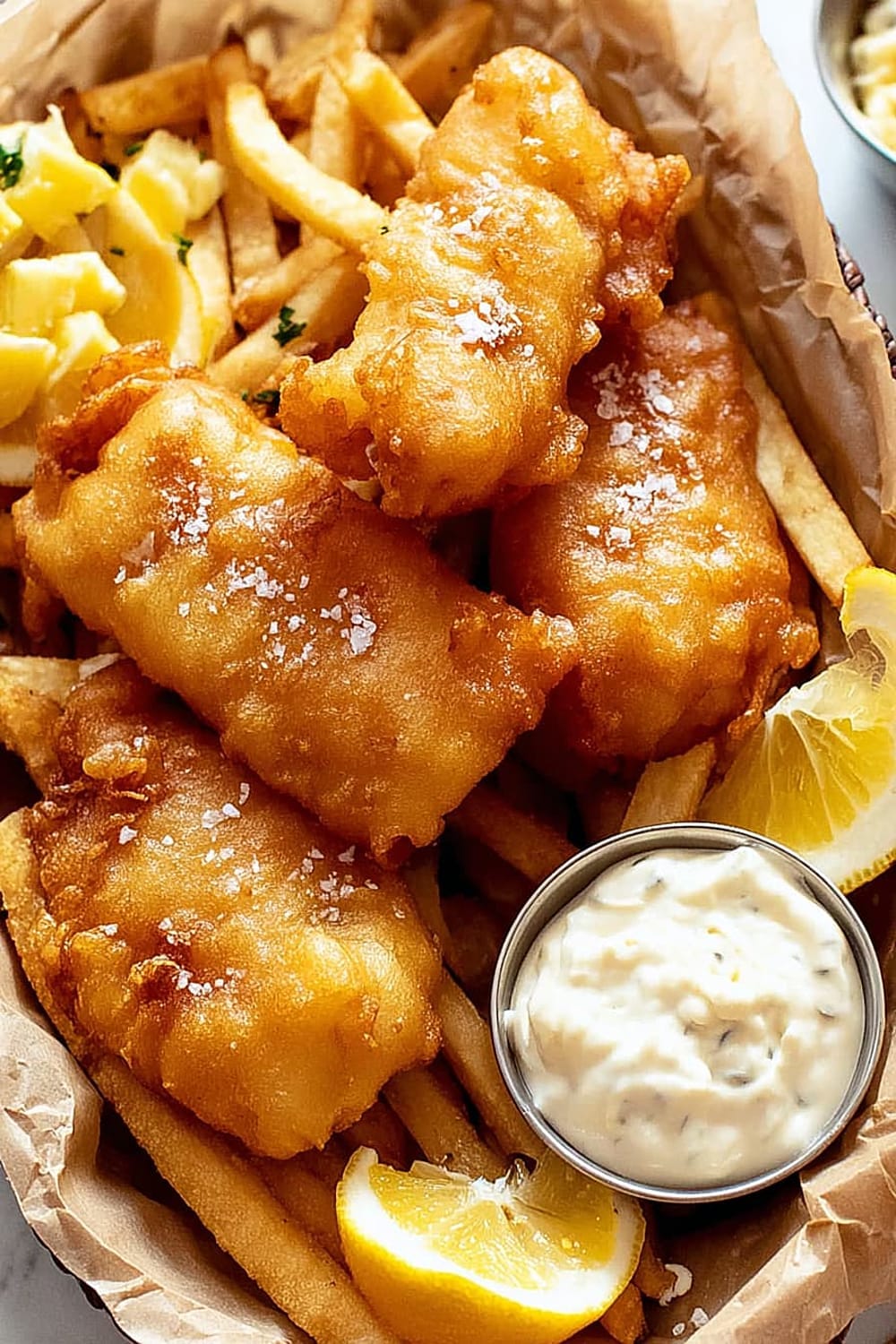
The secret weapon here is the combination of rice flour and ice-cold beer that creates the most impossibly light, crispy coating that stays crunchy for a solid 15-20 minutes – though let’s be honest, it’ll disappear way before then.
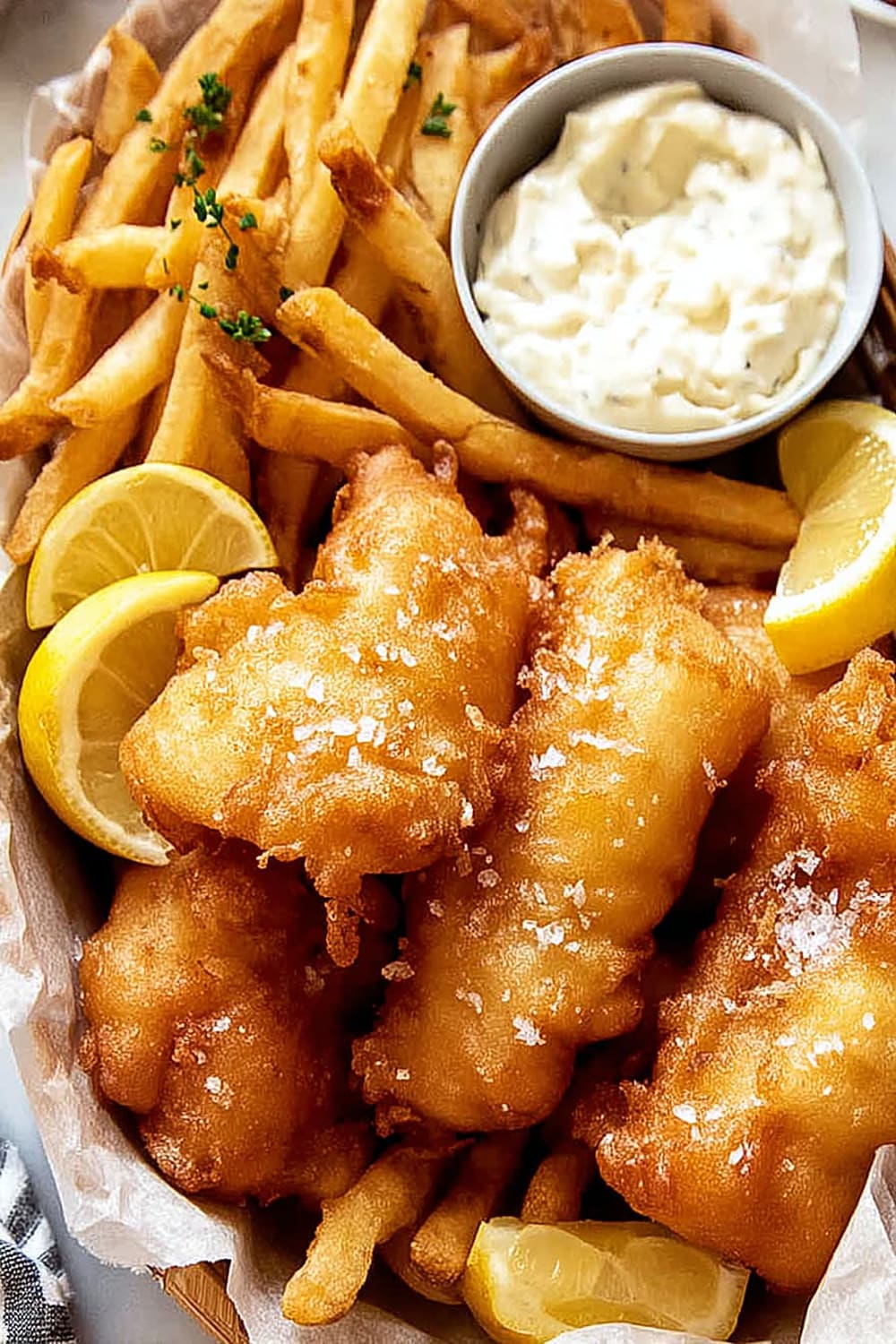
You’re about to discover why fish and chip shops guard their batter recipes like state secrets, because this creates that perfect puffy, golden shell that shatters when you bite into it.
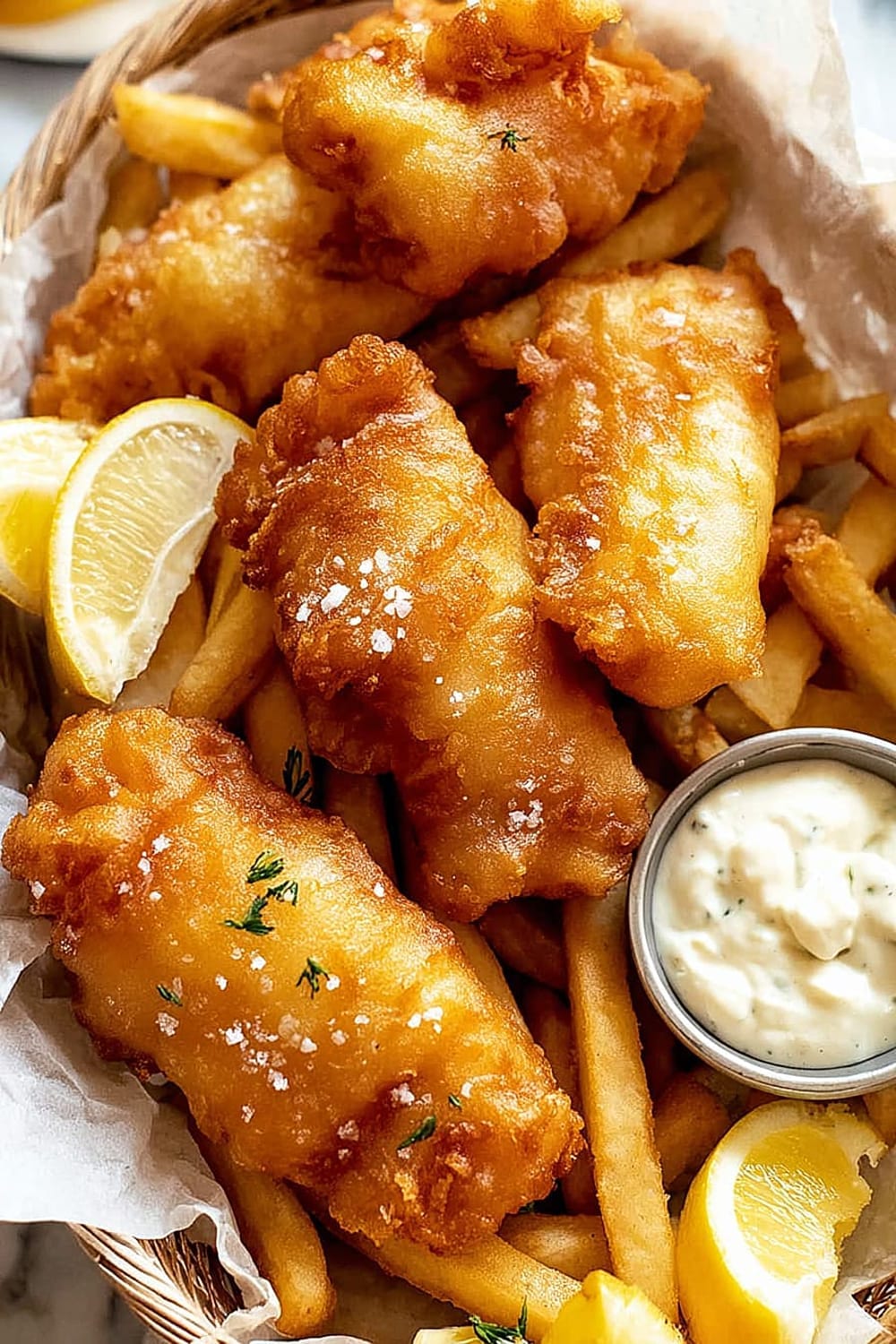
The carbonation and yeast in the beer work together to create tiny air pockets that puff up the moment they hit the hot oil, giving you that restaurant-quality texture at home.
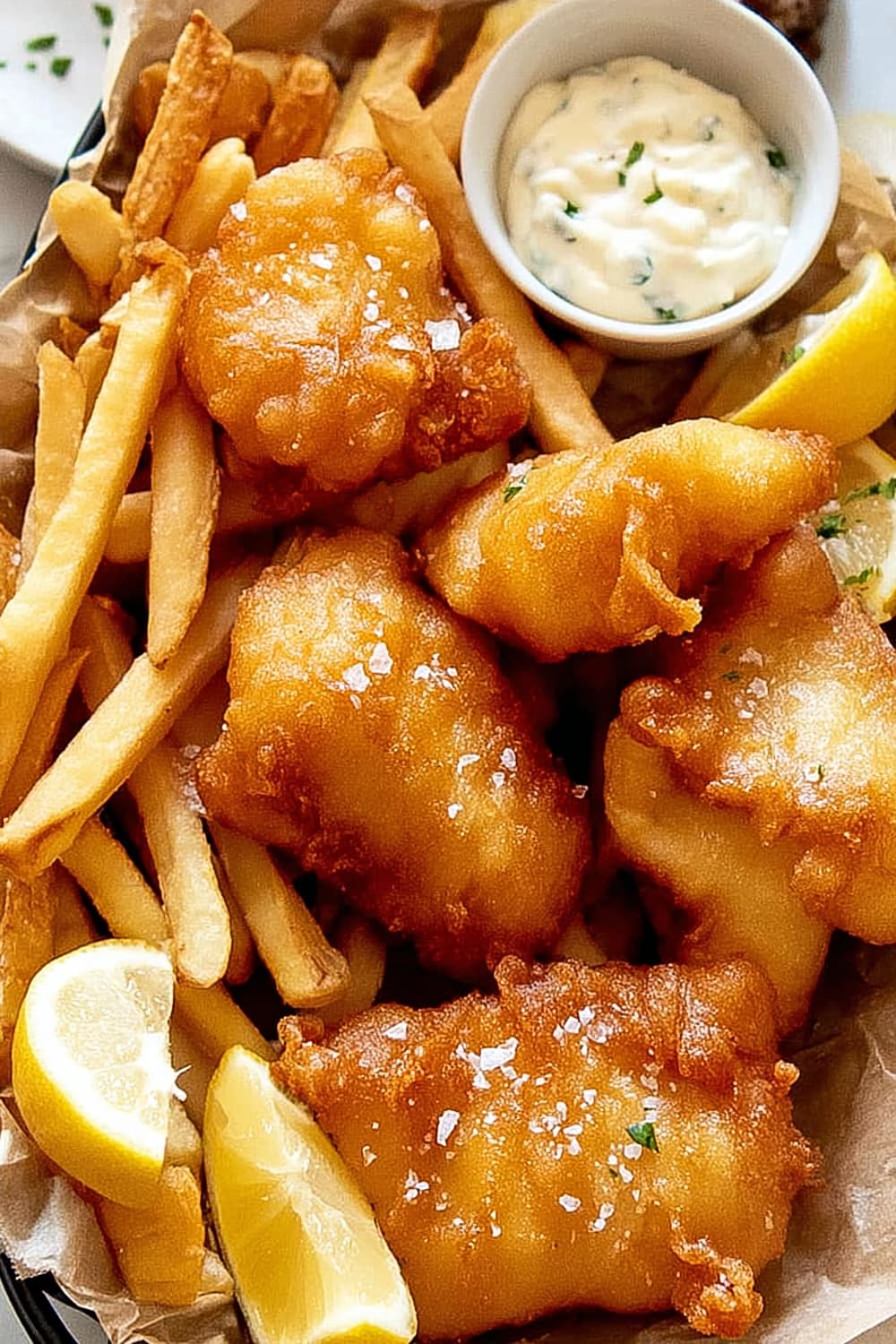
Don’t worry about the beer flavor – it completely disappears during cooking, leaving behind only the most incredible crispy coating that’ll have people begging for your recipe.
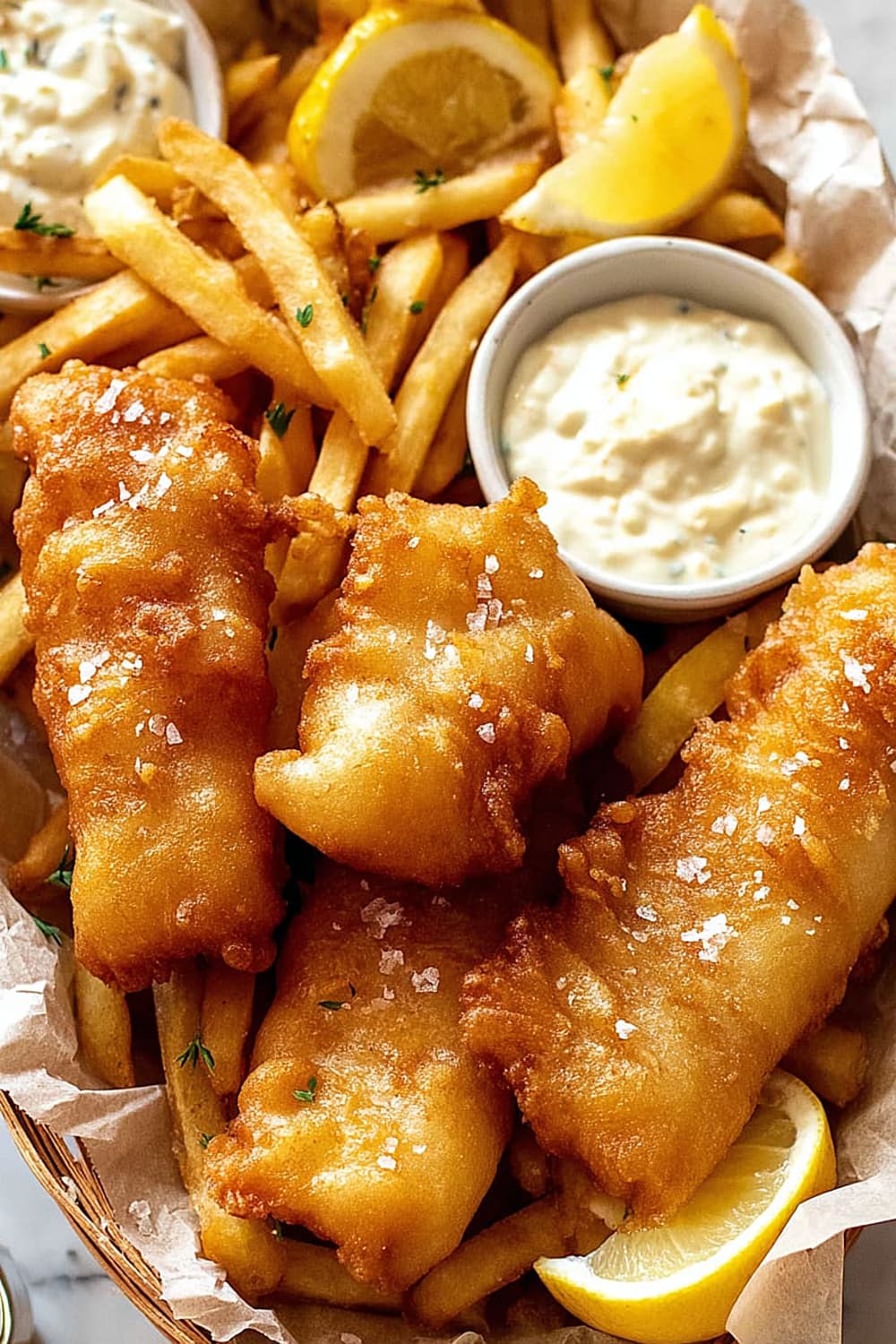
This is the kind of dish that transforms a regular Tuesday night into something special, and makes you feel like a proper chef even if you’re cooking in your pajamas.
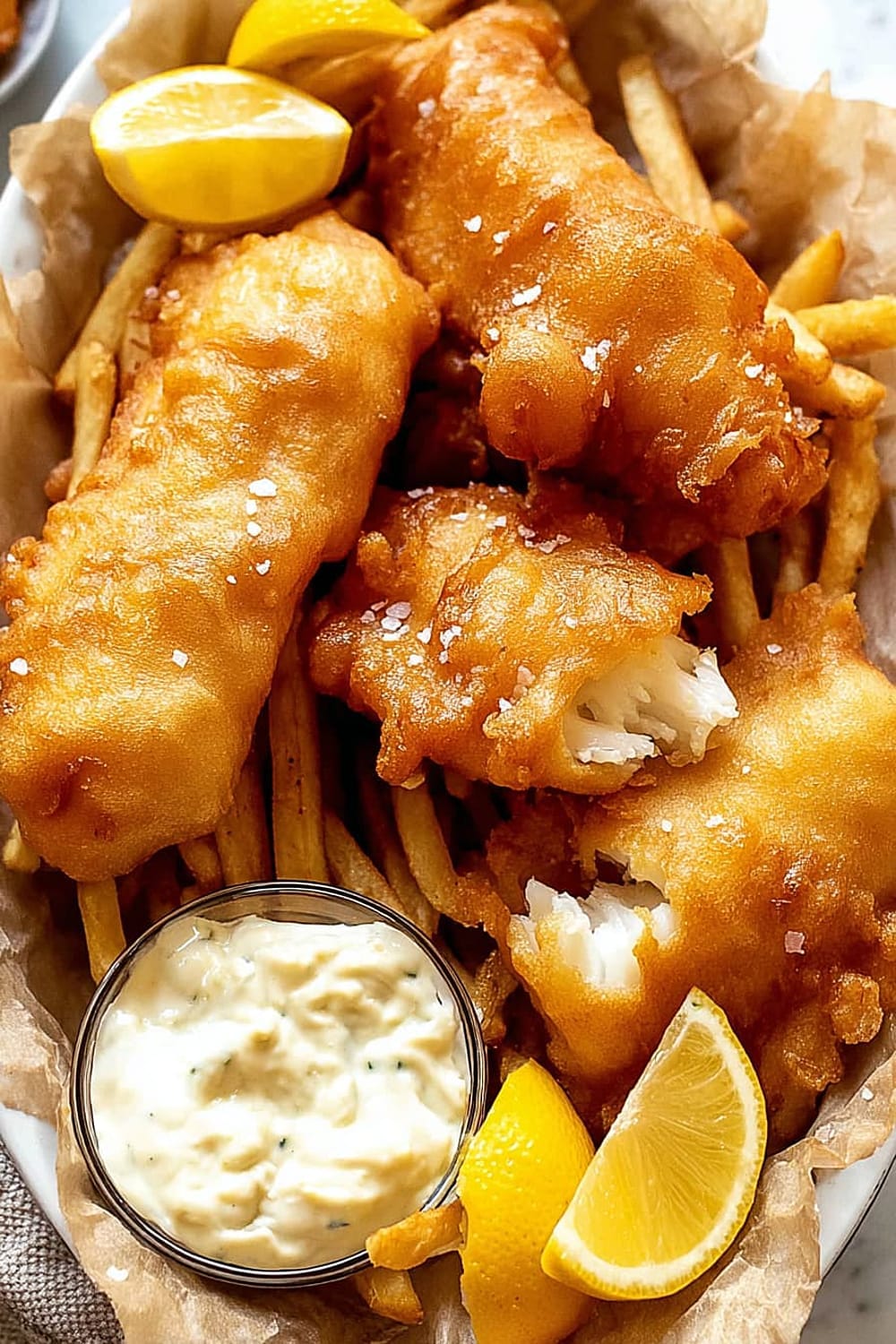
Ingredients
For the Fish
- 700 g (1.4lb) white fish fillets – flathead, snapper, whiting, cod, or tilapia work perfectly (skinless and boneless)
For Dusting
- ¼ cup rice flour – this prevents the batter from sliding off
For the Crispy Beer Batter
- ¾ cup plain all-purpose flour
- ¼ cup rice flour – the secret to ultra-crispy coating
- 1¼ teaspoons baking powder
- ¼ teaspoon salt
- 1 cup very cold beer – avoid dark beers like stout or porter
For Cooking
- 4-5 cups peanut oil – or vegetable, canola, or cottonseed oil for frying
For Serving
- Tartare sauce
- Lemon wedges
- Homemade crispy French fries
- Baked potato wedges
Instructions
Preparation
- 1 Pat fish completely dry using paper towels or a clean tea towel, removing every bit of moisture. Cut into 7 x 3cm (3 x 1¼ inch) batons, or leave as larger fillets if you prefer. For very thick fillets, slice them in half horizontally to ensure even cooking and proper batter adhesion.
- 2 Place ¼ cup rice flour in a shallow bowl for dusting. This creates a dry surface that helps the wet batter cling to the fish instead of sliding off during frying.
- 3 Heat 6cm (2-3 inches) of oil in a large heavy-based pot over medium-high heat until it reaches 190°C (375°F). Use an instant-read thermometer for accuracy – this temperature is crucial for achieving the perfect crispy texture without greasy results.
Preparing the Fish
- 4 While oil heats, sprinkle 3-4 pieces of fish with a pinch of salt, then coat completely in rice flour, shaking off any excess. The fish can sit like this for up to 10 minutes without issues, which helps with timing your batches.
Making the Batter
- 5 Just before cooking, whisk together the ¾ cup plain flour, ¼ cup rice flour, 1¼ teaspoons baking powder, and ¼ teaspoon salt in a medium bowl. Add the very cold beer and whisk just until the ingredients are incorporated evenly – don’t worry about flour lumps, and avoid over-mixing which can make the batter tough. The consistency should coat the back of a spoon but still drip off easily. If too thick, add beer 1 teaspoon at a time.
Frying Process
- 6 Dunk one piece of fish into the batter, ensuring complete coverage, then let excess drip off very briefly – you want a good coating but not a thick, heavy layer.
- 7 Carefully lower the battered fish into the hot oil, dropping it away from you to prevent splashing. Don’t crowd the pot – fry in batches of 3-4 pieces maximum. Fry for exactly 3 minutes total, flipping after about 2 minutes, until the coating turns a deep golden brown color.
- 8 Remove fish with a slotted spoon and drain on paper towels. Repeat the process with remaining fish, allowing oil temperature to return to 190°C (375°F) between batches. Serve immediately while hot, though the coating will stay crispy for 15-20 minutes.
Recommended Equipment and Kitchen Tools
Essential Tools (for best results)
- Instant-read thermometer – Maintaining the correct oil temperature at 190°C (375°F) is absolutely critical for crispy, non-greasy results
- Heavy-based pot or Dutch oven – Provides even heat distribution and prevents dangerous temperature fluctuations during frying
- Wire cooling rack over baking sheet – Allows excess oil to drain while keeping the bottom of your fish crispy instead of soggy
- Long-handled slotted spoon or spider strainer – Safely removes fish from hot oil while draining excess oil
Helpful Upgrades
- Kitchen scale – Measuring ingredients by weight ensures consistent results every time, especially important for the flour ratios
- Whisk with comfortable grip – Makes incorporating the cold beer into flour mixture easier without overworking the batter
- Shallow wide bowls – Perfect for dusting fish and holding batter at the right depth for easy coating
Nice-to-Have Options
- Splatter screen – Keeps your stovetop clean during the frying process and prevents oil burns
- Paper towel-lined plates – Set up multiple draining stations for efficient batch cooking
- Tongs with silicone tips – Helpful for handling fish pieces without piercing the delicate coating
Recipe Variations and Dietary Modifications
Gluten-Free Adaptation
- Replace all-purpose flour with ¾ cup gluten-free flour blend (ensure it contains xanthan gum)
- Keep the rice flour as specified – it’s naturally gluten-free and crucial for crispiness
- Use certified gluten-free beer like Omission or Glutenberg
- Expect slightly different texture but equally crispy results
Lighter Version
- Use light beer instead of regular beer for fewer calories
- Try air-frying at 200°C (400°F) for 8-10 minutes, flipping halfway through
- Reduce oil to just enough for shallow frying in a cast iron skillet
Flavor Variations
- Spicy version: Add ½ teaspoon cayenne pepper and 1 teaspoon paprika to the flour mixture
- Herb-crusted: Mix in 1 tablespoon dried herbs like dill, parsley, or thyme to the batter
- Asian-inspired: Replace beer with ice-cold sparkling water and add 1 teaspoon garlic powder
- Lemon pepper: Add zest of 1 lemon and ½ teaspoon black pepper to the flour mixture
Fish Alternatives
- Firm white fish: Halibut, mahi-mahi, or sea bass work beautifully
- Sustainable options: Look for MSC-certified fish or locally caught varieties
- Shellfish adaptation: Works perfectly with large shrimp or scallops, reduce cooking time to 2 minutes total
Nutritional Information and Health Benefits
Key Nutritional Highlights
Each serving provides approximately 320-380 calories, with the majority coming from high-quality protein and healthy fats from the frying oil. The fish contributes around 25-30 grams of complete protein, containing all essential amino acids needed for muscle maintenance and repair. The beer batter adds roughly 15-20 grams of carbohydrates, while the frying process contributes 18-22 grams of fat, depending on oil absorption.
Health Benefits of Main Ingredients
White fish like cod and snapper are excellent sources of lean protein, vitamin B12 for nervous system health, and selenium which acts as a powerful antioxidant. These fish varieties also provide phosphorus for strong bones and teeth, plus niacin (vitamin B3) that supports healthy cholesterol levels. The rice flour contributes easily digestible carbohydrates and is naturally gluten-free, making it gentler on sensitive digestive systems than wheat flour.
Dietary Considerations
This recipe contains gluten from the all-purpose flour and potential allergens from the beer (which may contain barley or wheat). It’s naturally dairy-free and can easily accommodate pescatarian diets. For optimal health benefits, pair with fiber-rich sides like roasted vegetables or a fresh salad to balance the meal’s macronutrient profile and add essential vitamins and minerals.
Smart Swaps and Ingredient Substitutions
Beer Alternatives:
- Cold sparkling water → Replace 1:1 with ice-cold club soda or sparkling water for alcohol-free version
- Different beer styles → Lager, pilsner, or wheat beer work perfectly; avoid dark stouts or IPAs
- Flat beer emergency → Add ¼ teaspoon extra baking powder to compensate for lost carbonation
Flour Substitutions:
- All-purpose flour → ¾ cup bread flour for slightly chewier texture, or ¾ cup cake flour for extra light coating
- Rice flour → ¼ cup cornstarch works as emergency substitute, though texture won’t be quite as crispy
- Gluten-free option → Use Bob’s Red Mill 1-to-1 Gluten Free Flour as direct replacement
Oil Options:
- Peanut oil → Vegetable or canola oil work equally well with similar smoke points
- Lower quantity frying → Use 2-3 cups oil in a cast iron skillet for shallow frying method
- Reusable oil → Strain and store properly used oil for 2-3 more frying sessions
Fish Flexibility:
- White fish fillets → Fish portions or steaks cut into appropriate sizes
- Fresh fish → Thawed frozen fillets work perfectly if properly drained and patted dry
- Sustainable swaps → Check local fish market for seasonal white fish varieties
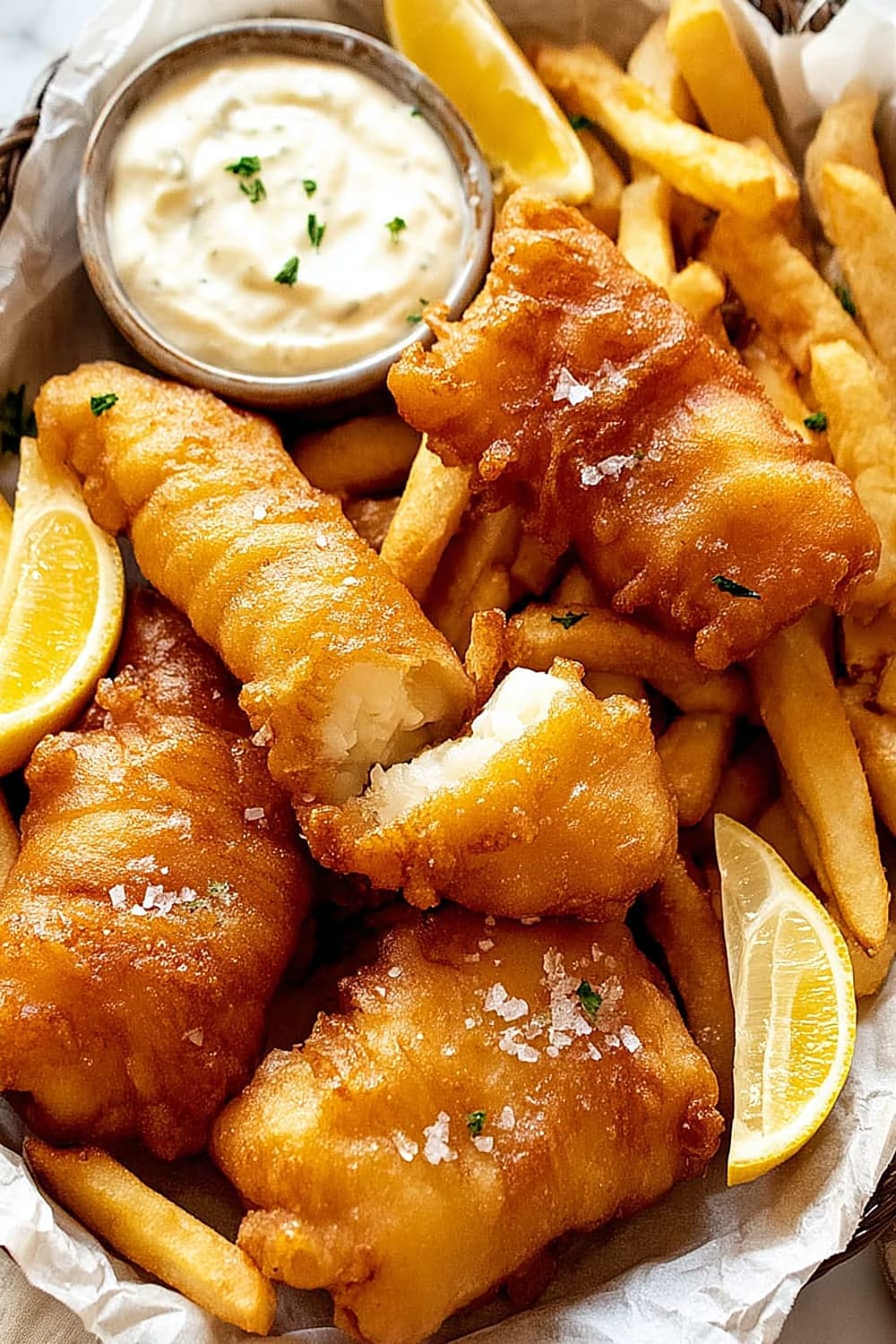
Make It Diabetes-Friendly
Carb Reduction Strategies:
- Replace ¼ cup rice flour with ¼ cup almond flour to reduce carbs by approximately 15 grams per batch
- Use ½ cup all-purpose flour + ¼ cup protein powder instead of ¾ cup flour to lower carbs while adding protein
- Try coconut flour at ⅓ the amount (so ¼ cup total) but add 1 extra egg to the batter for binding
Portion Control Tips:
- Stick to 4-5 oz fish portions (about 2 pieces from this recipe) to keep carbs around 8-12 grams per serving
- Pair with non-starchy vegetables like roasted broccoli or green salad instead of fries
- Calculate approximately 15-18 grams total carbs per serving with traditional recipe
Smart Pairing Suggestions:
- Serve with cauliflower mash instead of potato wedges to save 20+ grams carbs
- Add avocado slices for healthy fats that help slow glucose absorption
- Include fiber-rich coleslaw to help moderate blood sugar response
Cooking Method Modifications:
- Try air-frying to reduce oil absorption and overall calories
- Use spray oil instead of deep frying to cut calories while maintaining crispiness
Total Carb Reduction: These modifications can reduce carbs from 18 grams to 8-10 grams per serving
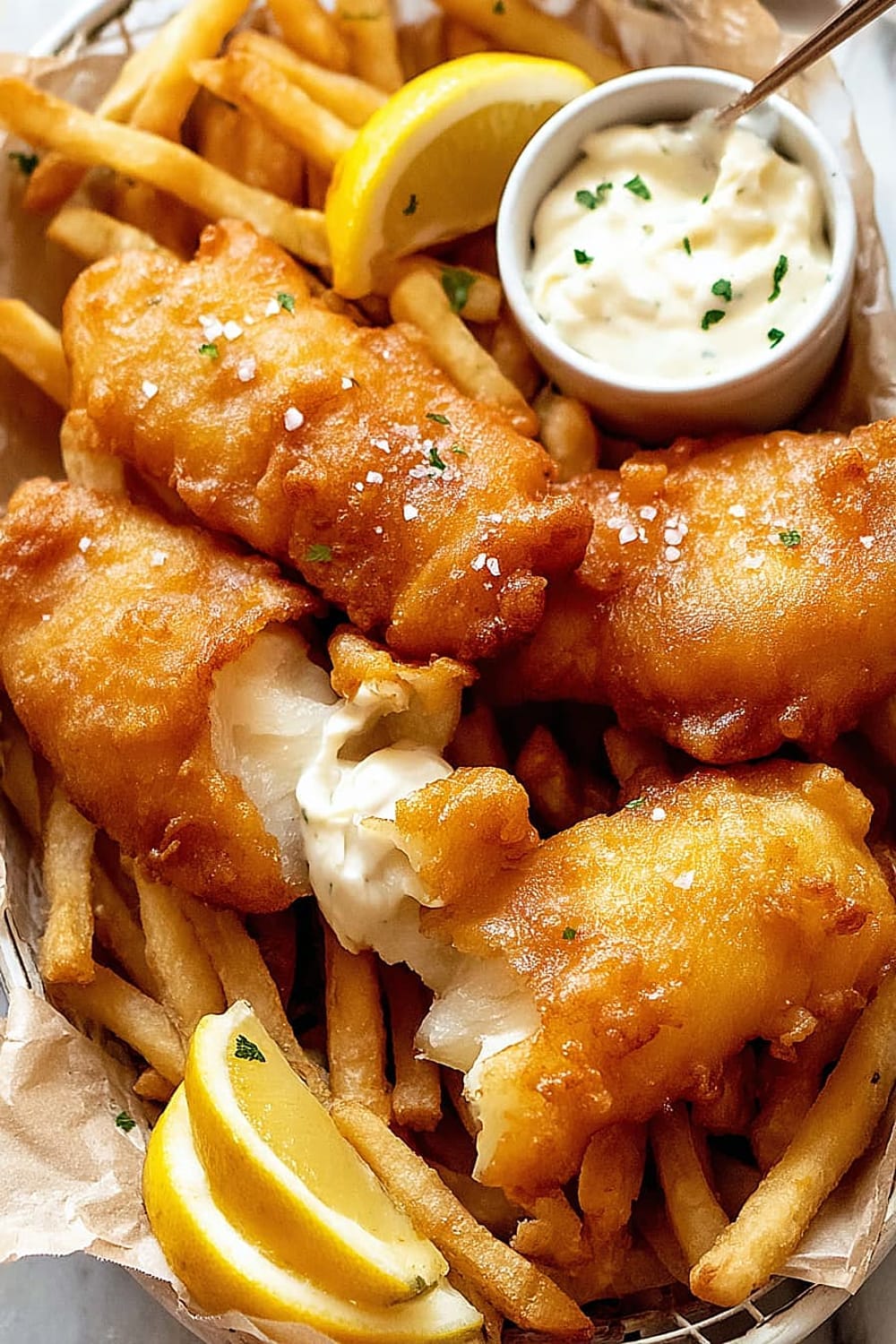
Perfect Pairing Suggestions
Beverage Pairings
A crisp lager or pilsner complements the light, crispy coating without overwhelming the delicate fish flavors, while a dry white wine like Sauvignon Blanc or Pinot Grigio provides acidic brightness that cuts through the richness. For non-alcoholic options, sparkling water with lemon or iced tea with mint offers refreshing contrast to the fried coating. Fresh lemonade or lime-infused sparkling water also provides the acidic element that makes fried foods more enjoyable.
Side Dish Recommendations
Homemade coleslaw with tangy vinegar-based dressing provides crucial textural contrast and helps cut through the richness of the fried fish. Roasted asparagus or steamed broccoli adds color, nutrients, and a fresh element to balance the meal. Crispy roasted potatoes or sweet potato fries complement the fish without competing, while mushy peas offer the traditional British fish and chips experience. Fresh garden salad with lemon vinaigrette provides lightness and acidity.
Complete Meal Ideas
Start with shrimp cocktail or oysters to create a full seafood feast, then serve the fish as the main course alongside twice-baked potatoes and grilled vegetables. For casual entertaining, create a fish and chips platter with multiple dipping sauces, onion rings, and pickle spears. End with lemon sorbet or key lime pie to cleanse the palate after the rich, fried main course.
Pro Tips and Troubleshooting
Temperature Control Mastery
The oil temperature will drop when you add fish, so start slightly higher at 195°C (383°F) and let it settle to 190°C (375°F) once the fish goes in. If your oil gets too hot and starts smoking, remove it from heat immediately and let it cool before continuing. Use a heavy-based pot that retains heat well, and fry in small batches to maintain consistent temperature throughout the cooking process.
Batter Consistency Secrets
The perfect batter should coat the back of a spoon but still drip off in ribbons – if it’s too thick, your coating will be heavy and doughy. Keep your beer refrigerator-cold until the moment you use it, as the temperature shock creates extra lift and crispiness. Don’t make the batter more than 5 minutes before using it, as the carbonation will dissipate and the flour will hydrate too much.
Storage and Reheating
Store leftover fish in the refrigerator for up to 2 days, but never attempt to reheat it in the microwave as this will make the coating soggy. Instead, reheat in a 200°C (400°F) oven for 5-8 minutes until the coating crisps up again. For best results, place on a wire rack over a baking sheet to allow air circulation around the fish.
Make-Ahead Strategy
You can cut and dust the fish up to 4 hours ahead, storing it covered in the refrigerator. Mix the dry ingredients for the batter in advance, but don’t add the beer until you’re ready to cook. The oil can be heated while you prepare the first batch of battered fish for maximum efficiency.
This beer battered fish recipe transforms your kitchen into the best fish and chips shop in town, delivering that perfect combination of flaky fish and shatteringly crisp coating that’ll have everyone asking for seconds. The science behind the rice flour and ice-cold beer creates restaurant-quality results that stay crispy longer than you’d expect, making it perfect for feeding a crowd or just treating yourself to something special on a weeknight.